Hawaii Part 1: Bright and Early at the Honolulu Fish Auction
HONOLULU, OAHU — Long before the sun comes up six days a week, Pier 38 is a frenzy of activity even in deepest darkness.
As early as 1 a.m., fishing vessels that have been 200 miles out in international waters pull into port to unload their formidable fresh catch at the Honolulu Fish Auction, the largest such auction in the United States. (The only other one is in Maine.)
The fish — bigeye tuna, swordfish, mahimahi and others — are weighed and tagged with the name of the vessel that caught each one. Then, the fish are put on display in row upon row of ice-heaped pallets inside an expansive warehouse kept at a frigid temperature to maintain the integrity of the seafood.
At 5:30 a.m. sharp, the auctioneer rings a brass bell to signal the start of bidding on that day’s bounty from the sea.
I had a chance to witness this extraordinary auction on a recent trip to the islands, courtesy of the Hawaii Visitors and Convention Bureau.
A small army of distributors and retailers (all men) move as one down each long row of fish, following the auctioneer and bidding against one anther for each fish until a final price per pound is determined. Once it is, the buyers move on to the next fish. And so on, until the last fish is sold, usually around 9 a.m.
Just as most of us are getting ready to sit down at our office desk with a cup of coffee, about 50,000 pounds of fish have been sold and are already on their way to seafood stores and some of the best chefs in Hawaii. Most of the fish is consumed locally, with less than 2 percent ending up in foreign markets.
Each year, the Hawaii fishing industry catches about 28 million pounds of ocean fish, worth more than $70 million.
And what fish it is. Prized bigeye tuna that tips the scale at 128 pounds. Opah, also called moon fish, because of its distinctive circular body. Mahimahi, whose sex can be identified readily because the male has a square head while the female a round one.
The fish sell for anywhere from $1 to $9 a pound wholesale, depending upon species and time of year, says Brooks Takenaka, general manager of the United Fishing Agency, which has operated the auction since 1952. By the time it gets onto your plate at a fancy Waikiki hotel restaurant, don’t be surprised if the tab you pay for that fish dish reaches $38.
But that’s the price of quality.
Tuna especially is big business here. Each one that comes into this warehouse is cut into. A small section near the tail is cut off to show the color of the meat. Bright red is sought after, as are streaks of white, which indicates a high fat content. A blue ring around the eye is another indicator of freshness, Takenaka says.
All the fish here are caught by hook and line. No boats in the fleet use gill nets, trawl nets or seine nets — all of which can be destructive to species and their environment.
Takenaka points with pride at Hawaii having one of the best managed fisheries around. It’s the only fishery to stop fishing once it reaches its international quota for bigeye tuna, he says. Moreover, a federal observer is stationed on 20 percent of the boats that go out for tuna and all of the boats that fish for swordfish, a species that once was overfished worldwide but now is considered a “best choice” by the Monterey Bay Aquarium’s “Seafood Watch Guide” when it is Hawaiian-caught.
Of course, one of the advantages of an auction like this is that diners get to enjoy fish that is as fresh as it gets.
After our visit to the fish auction bright and early, it was time for breakfast. So, we walked a few feet to Nico’s Pier 38, where classically-trained, French Chef Nicholas “Nico” Chaize, operates a bare-bones plate-lunch cafe that conveniently opens at 6:30 a.m., after he’s made it back from the fish auction with his provisions.
You can have the fish of the day (ahi when we were there) with eggs any way you like or stuffed inside an omelet with green onions, alongside fresh fruit and a scoop of rice for all of $7.
I can’t say I’ve ever eaten a fish omelet before, and certainly not at that early hour sitting at an al fresco table with the morning rays of the sun warming my cold hands and a salty ocean breeze ruffling my hair. But I’ll always remember it as being one of the most enjoyable meals of my life with fish so fresh and simple, it was absolutely sublime.
Later that night, I had another chance to experience fish from that morning’s auction. Chef Jon Matsubara of Azure restaurant in the Royal Hawaiian and his crew also make their way to the auction each morning to buy their fresh fish.
When I spied opah on the menu, I had to order it after being mesmerized by the strange, round fish earlier that morning. Opah boasts the most heart-healthy Omega-3 fatty acids of any fish, according to Takenaka, but because of its skeletal structure, it also has one of the lowest yields of any fish when it comes to edible flesh.
Served with a creamy sesame-ginger buerre blanc, the fish had been blackened on high heat, leaving its sweet flesh moist, flaky and almost fluffy.
I relished each bite, not only because it was delicious, but because after this morning’s experience, I truly appreciated all the effort and care that went into getting it from sea to plate.
Hawaii Part 2: A Look at Two of Oahu’s Pioneering Chefs
Hawaii Part 3: A Tale of Two Very Different Farmers
Hawaii Part 4: Four Magnificent Meals on Maui
Hawaii Part 5: Kona — Where Coffee is King

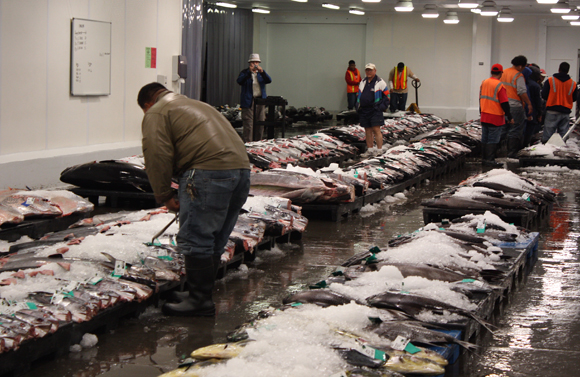
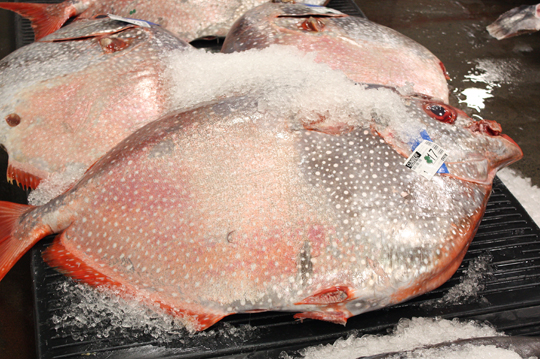
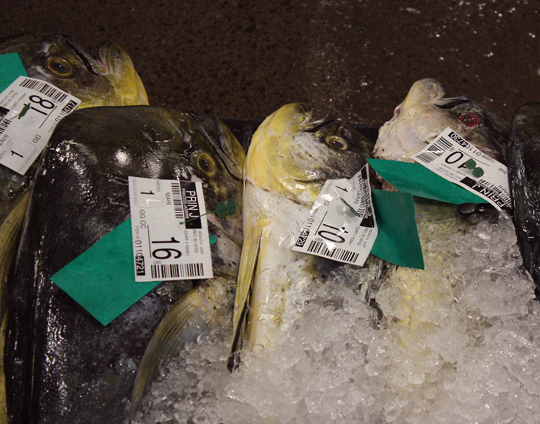
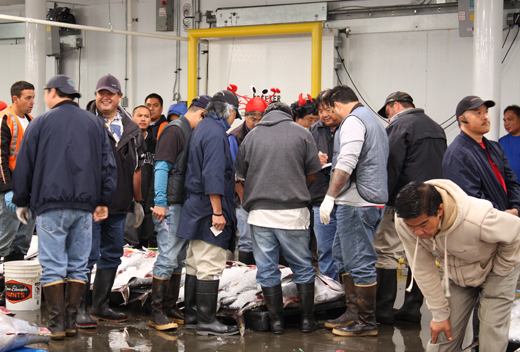
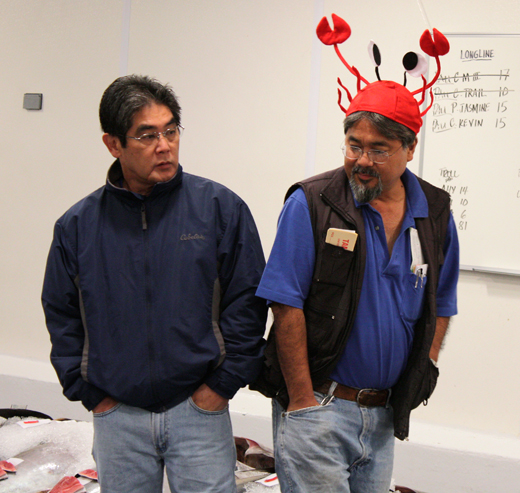
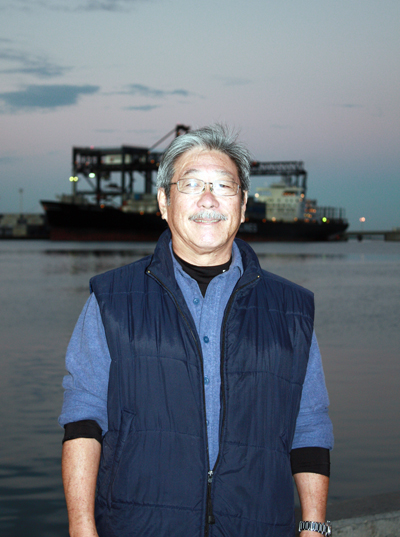
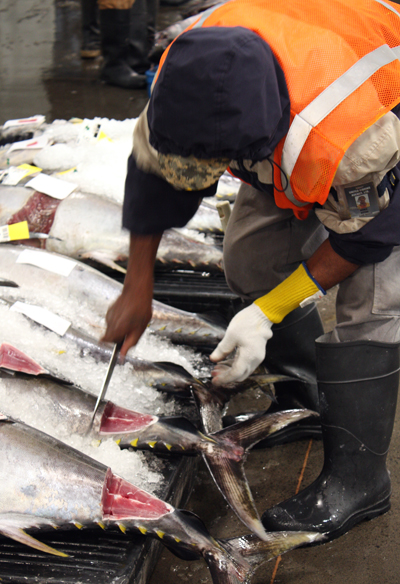
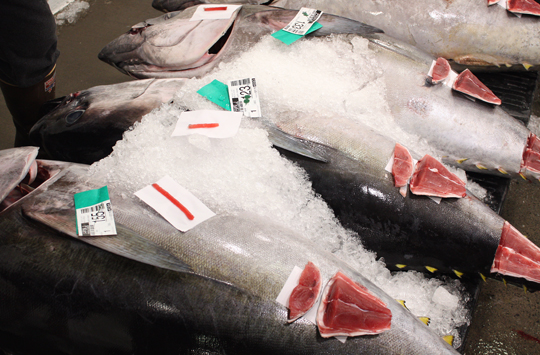
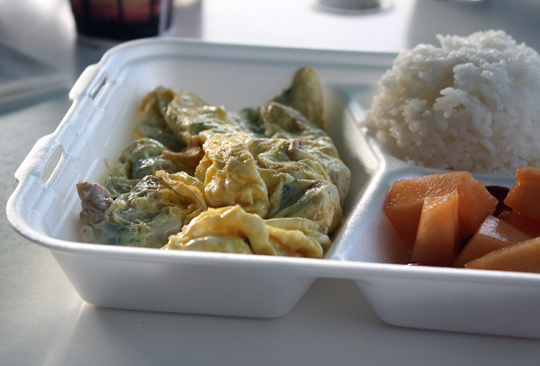
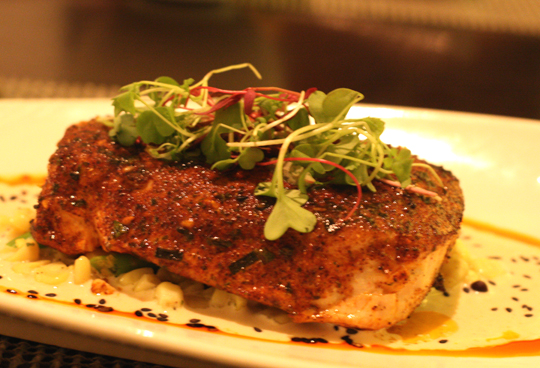
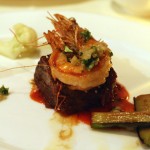

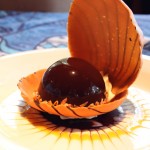

What an interesting place to visit!
Cheers,
Rosa
Fantastic post — it doesn’t get any fresher than that!
That’s fresh fish for ya!
OMG, all that fish is making me drool big time
Pingback: Monday November 28th, 2011 | Edible News
Dear Carolyn
I am always amazed at what goes on at the fish markets and the scenes you have shown are very similar at the Sydney Fish Markets too. Do auctions there bid up or down? I understand fish auctions in Japan bids down while it bids up here in Australia.
How fun! I love the idea of sesame-ginger buerre blanc too.
eggs with fresh fish, what a start to the morning!! great post!
Fascinating post Carolyn! And that’s fantastic that it’s all caught by hook and line-that’s not the case here. And it’s a very blokey environment isn’t it?
This reminds me a LOT of hte south street seaport…but with a way better fish selection!
Pingback: Food Gal » Blog Archiv » Hawaii Part 2: Chefs Who Pioneered Hawaiian-Regional, Fine-Dining Cuisine
What a wonderful and delicious experience!
Living in MI. the only time I have fish this fresh, is when I catch it myself
Just love this post which beautifully illustrates all the hard work that goes into getting that fish on our plate. The Opah fish sounds delicious & I’ll make sure to try it next time I visit Hawaii.
BTW you are sooooo lucky to be there!
I grew up in Honolulu and never made it to the fish market. So not a morning person, although that tuna omelet could definitely wake me up.
Pingback: Food Gal » Blog Archiv » Hawaii Part 3: A Tale of Two Very Different Farmers
Ben: As often as you go to Hawaii, you definitely need to get to this fish auction just once. I’m not a 5 a.m.-wake-up kind of gal, either. But it was so worth it to experience it all. Plus, heck, your reward at the end is a delicious fish omelet that’s guaranteed to shake the sleep from your eyes and put a smile on your face.
Opah is my favorite fish! So ono!!
My husband has been to Tsukiji (Tokyo fish market) and he was so thrilled about the experience. Your story reminded me of that. He said the sushi store right near the fish market has very inexpensive fresh sushi. It must be so good to eat the dish which came right from the market!
Pingback: Food Gal » Blog Archiv » Hawaii Part 4: Four Magnificent Meals on Maui
I’m jealous! I’d love to visit the Hawaiian fish auction. No better place for the freshest fish.
I’ve wanted to go to the fish auction (and Nico’s) for a long time now, but never seem to find the time to go during our vacations. *sigh* Maybe next time.
Pingback: Island Fever. Island Peace. - Misadventures with Andi
there is a website. http://www.hawaiilocalfood.com where fishermen and farmers can list what they have for sale. we need more food sellers to list themselves.
Ooh yes we’re comin’ in loaded, Ooh yes we’re comin’ in loaded
I’ll hold the boat steady brother like a rock
Full speed a head until we hit the dock
We’re heading for home, the fishing was great
We’re comin’ in loaded ’cause we’re all out of bait…